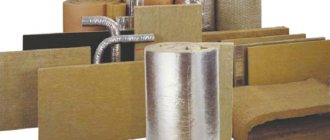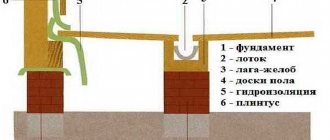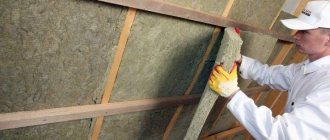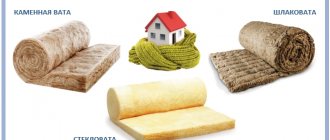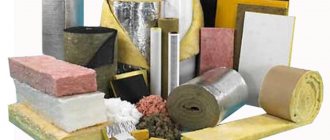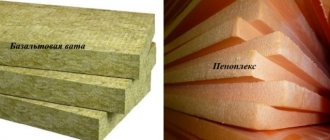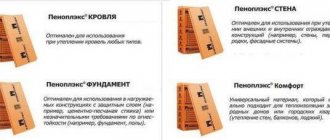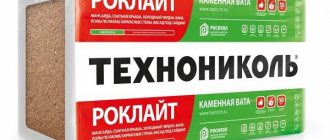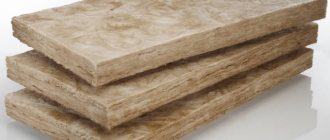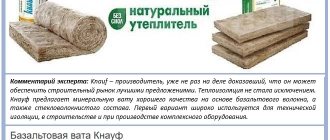Types of mineral wool
The popular insulation mineral wool comes in different types. It differs in the raw materials from which it is produced, in the release form, density and other parameters. All types have one thing in common: it is a loose material with low density and a fibrous structure, due to which mineral wool has low thermal conductivity.
Classification by composition
Various rocks, waste slag, and glass are used as raw materials for the production of fibrous insulation. Depending on this, it is divided into the following types:
- Rock wool is a product of processing the melt of igneous rocks such as basalt and gabbro, which is why it is often called basalt. The content of these rocks in the insulation reaches 80%, and in addition to them, its composition includes synthetic binders (formaldehyde resin), the specific gravity of which does not exceed 10%, and mineral components such as limestone or clay. They increase the fluidity of the melt and can account for up to 30% of the total volume. The combination of components and their percentage may vary within the specified limits depending on the density and purpose of the mineral wool, the purity of the raw materials, production conditions and other factors. The average length of the fibers of such insulation is 16 mm with a thickness of 8 to 12 microns;
Isover is one of the most popular brands of stone wool Source www.isover.ru
- quartz wool is a relatively new material on our market, the basis of which is molten quartz, which is contained in sedimentary rocks. Quartz fibers are longer and lighter than basalt fiber, and the material itself has higher elasticity;
- slag wool is very similar to stone wool in length and thickness of fibers, but it is made from molten blast furnace slag, charge and other waste from metallurgical production. Its technical characteristics are lower than those of its analogue made from natural components, which, however, is offset by a lower price;
- glass wool, as the name implies, is made from broken glass, as well as sand, borax, limestone, soda, and dolomite. Its fibers are quite long, up to 70 mm, of varying thickness. They are characterized by very high resistance to chemicals.
Glass fiber insulation Source homes66.ru
The performance characteristics of any type of mineral wool depend on the proportional ratio of the original components. And its production is regulated by regulatory documents, such as the international standard ISO 9229:2007 and the domestic GOST 31913-2011. Thermal conductivity, hydrophobicity, strength, degree of shrinkage and other important indicators must meet their requirements.
Classification by release form
Since the scope of application of mineral wool insulation is very wide, they are produced in various forms, which allows them to be used in a wide variety of designs. Depending on the shape and presence of coating, the characteristics and properties of mineral wool may differ.
- Mineral wool boards have the highest density and convenient dimensions, which allows them to be conveniently combined with most types of frames and facilitates storage and transportation. They are used for insulation of “wet” facades and loaded structures. For example, a basalt slab can even be laid under a concrete floor screed.
Standard slab width is 600 mm Source blog-potolok.ru
- Insulation in rolls and stitched mats is looser. It is designed for thermal insulation of surfaces that do not experience heavy loads - walls, ceilings, under-roof structures. And also for insulating large cross-section pipes, air ducts, caissons, equipment located in unheated buildings.
- Shells and hollow cylinders made of mineral wool are the most convenient and practical insulation for household pipes. In addition to them, manufacturers also produce shaped parts for insulating corners, tees and other pipeline components.
Thermal insulating mineral wool cylinders Source swatstroi.ru
See also: Contacts of construction companies that specialize in insulating houses
Since fibrous materials easily absorb water and absorb moisture from the air, products made from them are also produced with a protective coating of aluminum foil, kraft paper, fiberglass and other materials with similar properties.
Note! Regardless of the presence or absence of a protective screen, mineral wool is easy to cut, so the dimensions of the slabs or the length of the rolled material can be independently adjusted to the required parameters.
Classification by density grade
The density of insulation is one of its main parameters, affecting the weight and thermal insulation characteristics. According to this indicator, stone wool for insulation is divided into several grades, the digital designations of which indicate the density of the material in kilograms per cubic meter:
- P-75. These are the softest and lightest slabs with a density of only 75 kg/m3. They cannot withstand heavy loads, so they are used for thermal insulation of pipes as windings, as well as horizontal unloaded surfaces. When installed vertically, such materials gradually shrink and slide down.
It is recommended to insulate only horizontal structures with soft roll materials Source pro-uteplenie.ru
- P-125 and P150. Semi-rigid insulation of this brand can be mounted on horizontal, vertical and inclined surfaces as heat, sound insulation and fire protection. It is also laid between external and internal walls made of brick or concrete blocks in three-layer insulated structures.
- PZh-175, PPZh-200 belong to the category of rigid slabs that give minimal shrinkage. They can withstand the load corresponding to the marking, therefore they are used for insulating loaded structures such as flat roofs and reinforced concrete floors.
The brand of insulation affects the area of its application Source i.ytimg.com
In addition, mineral wool can differ in the arrangement of the fibers - chaotic or mutually perpendicular (lamella).
See also: Projects of houses without a garage
Disadvantages of thermal insulation material
Due to its hygroscopicity, mineral wool insulation requires mandatory protection from moisture. When using the material in a multi-layer structure, it is covered with hydro and vapor barrier fabric.
Another disadvantage of insulation is brittle fibers, which irritate the skin and mucous membranes during installation. This is especially true for glass and slag wool. They must be stowed in protective equipment and a respirator.
Consumers are concerned about formaldehyde substances in mineral wool. Insulation with phenolic compounds is best used outside, although it is not dangerous at normal temperatures. When using mineral wool, it is important to follow the technology and be sure to cover the layer of material with a vapor barrier film, which prevents dust from the fibers from entering the room and moisture from entering the thermal insulation.
Production Features
In order to obtain thin fibers from rocks or other solid raw materials, it is subjected to complex processing. First, it is melted in special shaft furnaces at a very high temperature, more than 1000 degrees. Moreover, the temperature must be maintained at a certain level, since the degree of viscosity of the molten raw material depends on it.
In this state, it is fed into centrifuges in which the rollers rotate at a speed of about 7 thousand revolutions per minute. In centrifuges, the melt is broken into fibers, which are covered with binding components and thrown into the next chamber by a strong air flow.
In it, the fibers are formed into carpets, and they are given the desired size and volume using a forming machine. Next, the “raw” basalt wool passes through a heat chamber, in which the binding components polymerize under the influence of high temperature, and the material acquires the required properties.
The final stage of production is cutting and packaging Source img.tyt.by
Pros and cons of stone wool
Time-tested is one of the main advantages of stone insulation. For example, ecowool made from paper has entered the market. It is lighter and cheaper and can be installed in a matter of hours by blowing into the base.
At the same time, ecowool has anti-flammable impregnations and protection against rotting. Manufacturers promise the insulation the same 50 years of service. However, there are no real-life examples of such resilience. Stone wool has already shown itself.
Despite the long history of mineral insulation, there are misconceptions about it. It is believed, for example, that stone wool for facades and interior decoration eliminates rodent infestations.
They won't eat the stone. The remark is reasonable. However, rats and mice do not eat cotton wool. They live in it. Thin fibers of insulation are easily chewed through. A network of passages and mouse houses is formed inside the cotton wool.
Therefore, rodents are not interested in stone material only conditionally. So, in the Moscow news there was a story about a house that was insulated under a major renovation program. Mineral wool was pushed into the façade.
They didn't cover it everywhere. There was a move left in the loggia of one of the residents of the house. The rats took advantage of it. Having made their way into the apartment, the rodents killed the pet turtle. This was the reason for the animal’s owner to go on television.
The undeniably ideal combination of high insulating properties and minimal weight in wool. The low weight of the insulation facilitates its installation. This is also facilitated by the resistance of cotton wool to temperature changes and the lack of expansion.
It is possible to lay mineral mats at -40 and +50 Celsius. It doesn’t matter whether the stone wool is taken from TechnoNIKOL or from a lesser-known manufacturer. The basic properties of insulation are the same under any label.
The environmental friendliness of stone wool is overshadowed only by the binding components. What kind of resins these are and whether they are resins at all is rarely explained. Theoretically, the adhesive composition of the insulation can pose a threat. However, it only appears when heated and should be small. Binding components in stone wool occupy no more than 7% of the total mass of products.
Main characteristics
If we talk about mineral wool in general, then all its types have similar properties. These include:
- low density, which varies from 10 to 150 kg/m3 depending on the brand and type of feedstock;
- good vapor permeability: mineral wool insulation does not interfere with air exchange and prevents the formation of condensation on insulated surfaces, which has a positive effect on the microclimate in the house;
- light weight, facilitating installation, carrying and transportation;
- low thermal conductivity coefficient, amounting to only 0.03-0.06 W/mG and directly dependent on the density of the material. In this indicator, it is second only to polystyrene foam and expanded polystyrene;
- high biological and chemical stability: mineral wool does not rot, does not contribute to the spread of putrefactive bacteria and mold, and is not destroyed by exposure to aggressive substances;
- fire resistance: depending on the type, mineral wool can withstand temperatures up to 300-700 degrees. Therefore, it can be used to insulate chimneys and heating pipes;
Non-combustibility is a significant plus of mineral wool Source www.ssk-inform.ru
Thermal insulation of the facade using mineral wool
The technology for thermal insulation of facades using mineral insulation is quite simple. This is due to the fact that mineral wool slabs are quite large in size and are easily mounted on the wall.
Facade slabs are produced in thicknesses from 5 to 15 cm. Insulation for external use is more dense and hydrophobic than for internal use.
Fixing mineral wool on the facade
Advantages of insulating facades using mineral wool:
- the slabs have good sound and heat insulation qualities;
- using mineral slabs you can hide wall defects;
- the material has a lower price than polystyrene foam;
- insulation is of no interest to rodents;
- installation and dismantling of the slabs is easy to do with your own hands;
- The material is fire resistant and has a melting point above 1000 degrees.
Video description
The following video will tell you about the installation rules using the example of insulating a pitched roof:
Dense and rigid boards can be glued to walls. This is what is done when installing “wet” facades. After installation, the slabs are primed and plastered over the reinforcing mesh.
The pipes are insulated by wrapping strips of mineral wool with an overlap and then securing them with wire or tape. And the insulating cylinders are selected according to the diameter of the pipes and are put on them with the joints glued.
Securing the insulating cylinder with clamps Source i.ytimg.com
